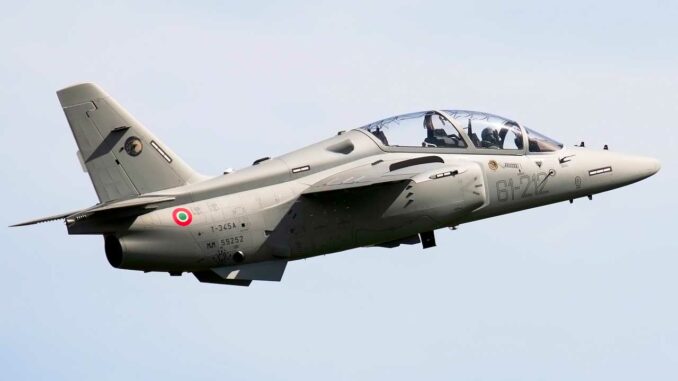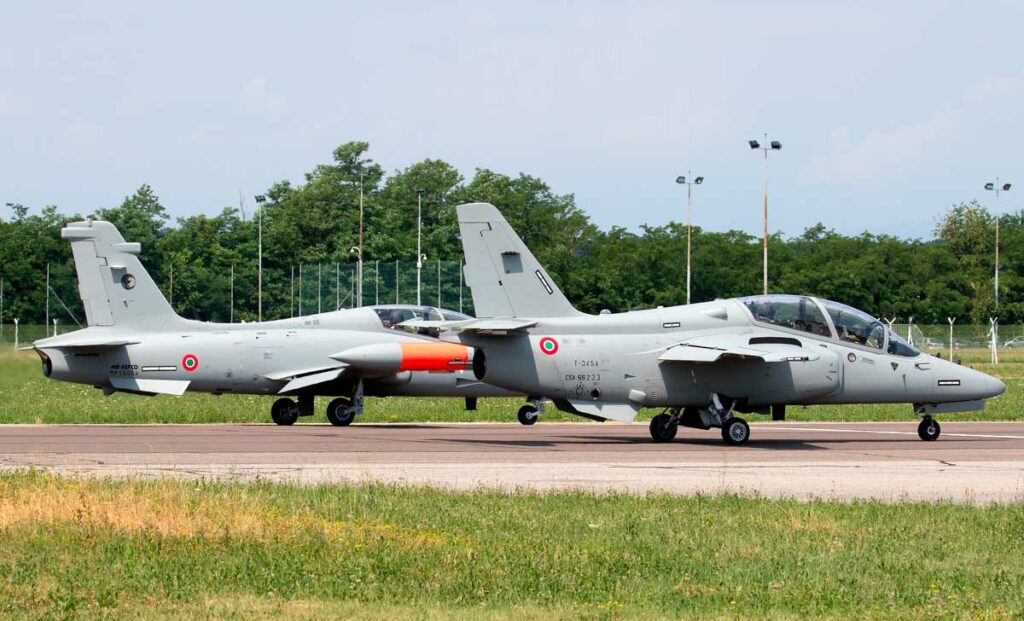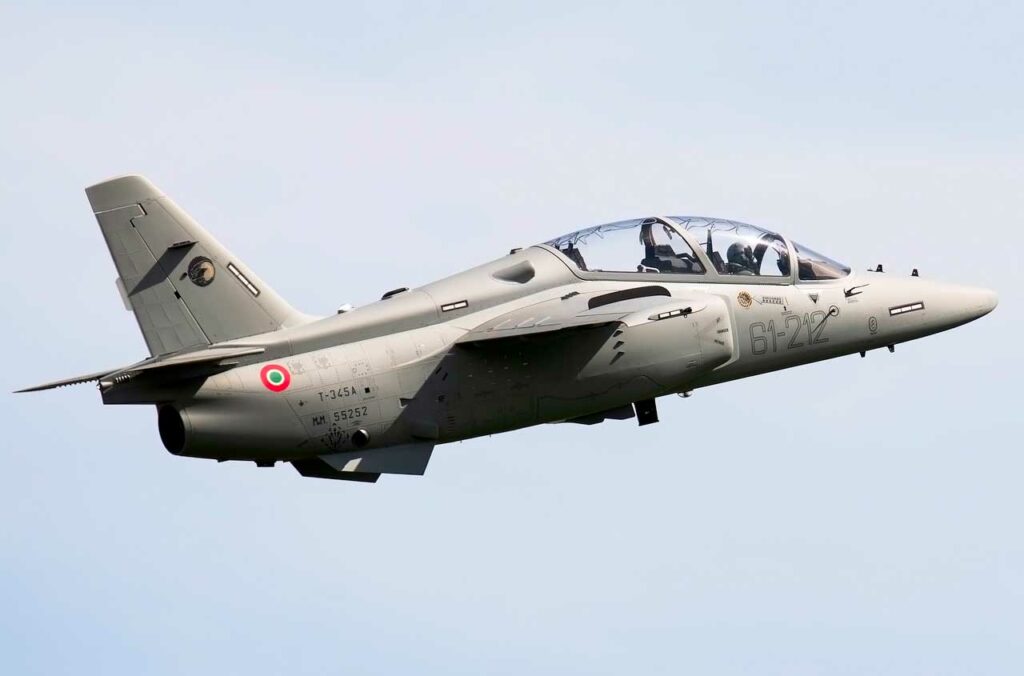
Leonardo’s M-345 enters service with the Italian Air Force as a basic training aircraft and light operational aircraft.
The M-345, a jet trainer developed by Leonardo, has been officially integrated into the Italian Air Force. Intended to replace the MB-339, it is now operational at Galatina Air Base alongside the M-346 advanced trainer aircraft. Powered by a Williams FJ44-4M-34 engine, the M-345 combines phases 2 and 3 of military pilot training. Equipped with modern digital control systems, multifunction displays, and real weaponry, it is also suitable for light missions. Its entry into service, although delayed since 2019, marks a turning point in the rationalization of Italy’s training resources.

An aircraft designed for initial fighter pilot training
The M-345 is intended to replace the MB-339, which has been in service for over 40 years. The aircraft covers the intermediate phases of military training: basic maneuvers, initial tactical training, formation flying, and initial familiarization with modern combat systems. It fits between the early training turboprop aircraft and the M-346 Master advanced jet trainer, used to simulate 4th and 5th generation fighter aircraft.
The aircraft is powered by a Williams FJ44-4M-34 turbofan engine with a thrust of 13.1 kilonewtons, enabling it to reach a maximum speed of 787 km/h at an altitude of 6,000 meters. This choice of engine reduces operating costs while offering superior performance to high-end turboprop aircraft such as the Pilatus PC-21 and the Beechcraft T-6 Texan II.
The Italian Air Force has ordered 18 units, of which seven have already been delivered and four have been used in operational trials, which were completed in March 2024. Four instructors are now certified. The model is fully integrated into the training program at the 61st Stormo de Galatina, which oversees the transition from basic flight to complex tactical training.
Leonardo says the hourly cost of the M-345 is similar to that of a turboprop, while offering an experience closer to fighter flight. This cost-effectiveness is a key argument for armies looking to optimize their training fleet.
Modern technical features for realistic training
The cockpit of the M-345 is fully digital. It includes three multifunction color touchscreen displays (MFDs), a head-up display (HUD), and a standardized cockpit interface compatible with modern combat aircraft. The aim is to familiarize student pilots from the outset with the digital environments they will encounter on the Rafale, F-35, and Eurofighter.
The aircraft also incorporates onboard simulation systems that can reproduce complex training scenarios in flight, including ground-to-air threats, enemy radar, simulated firing and ground support. This flight simulation concept reduces the need for ground-based simulation infrastructure and increases the autonomy of the training program.
The aircraft’s airframe is optimized for maintenance, with easy access to components, which reduces the average time between flights to less than two hours, an important factor for busy training centers.
Finally, the onboard systems allow complete flight recording, with post-mission playback on ground stations. Instructors can thus accurately analyze the trainee’s performance and correct errors with objective data.
This type of equipment places the M-345 at a higher level of sophistication than conventional training aircraft, bringing it closer to integrated training systems such as those used by the US Air Force (T-7A Red Hawk) and the Indian Air Force (HAL HTT-40).
Secondary operational capability for internal security missions
Beyond its training mission, the M-345 is compatible with live weapons, a feature rarely found in a training aircraft in this segment. It can carry up to 1,000 kg of payload distributed over four underwing hardpoints.
This capability allows it to perform light operational missions, including close air support, border surveillance, and attacks on lightly defended targets. It can be armed with:
- infrared-guided air-to-air missiles (AIM-9L or IRIS-T type),
- 227 kg (500 lb) unguided bombs,
- 70 mm rocket pods,
- external cannons of 12.7 mm or 20 mm.
In a context of budgetary restrictions, some countries may use these aircraft as light fighters, such as the M-346 FA, the armed version of the Master, which has already been sold to several countries in Africa and Asia.
The dual role of the M-345 – training and operations – may appeal to foreign customers looking for an aircraft that is inexpensive to purchase and maintain, while still capable of basic tactical missions. In terms of exports, this flexibility could be an advantage over competing aircraft from the US, South Korea, and Brazil.
Leonardo is relying on this strategy to offer the M-345 to armed forces with limited budgets or seeking to supplement their fleets with a versatile secondary aircraft. The estimated unit price is around €20 million, depending on the configuration and onboard systems.

Industrial challenges and place in the Italian aerospace ecosystem
The official launch of the M-345 comes at a time when Leonardo is seeking to streamline its training platforms around a model that complements the more powerful and more expensive M-346. The choice of an American engine (Williams) and upgradeable avionics reduces maintenance times and logistics costs.
Manufacturing of the M-345 is centralized in Venegono Superiore, in northern Italy, and involves a network of local subcontractors in the mechatronics, composite materials, and onboard electronics sectors.
This program supports the employment of more than 500 people in engineering, assembly, testing, and maintenance. It complements the production lines for military helicopters, Falco drones, and onboard electronic systems that Leonardo manufactures for the European market.
The decision not to assign the aerobatic role to this model, contrary to initial intentions, reflects a shift in priorities. The MB-339 will be replaced in the Patrouille Frecce Tricolori by the M-346, which is better suited to the dynamic developments in formation flying.
The complementarity of the M-345 and M-346 provides the Italian Air Force with a modular training system that meets the requirements of modern fighter pilot training, particularly for the transition to the F-35A.
War Wings Daily is an independant magazine.